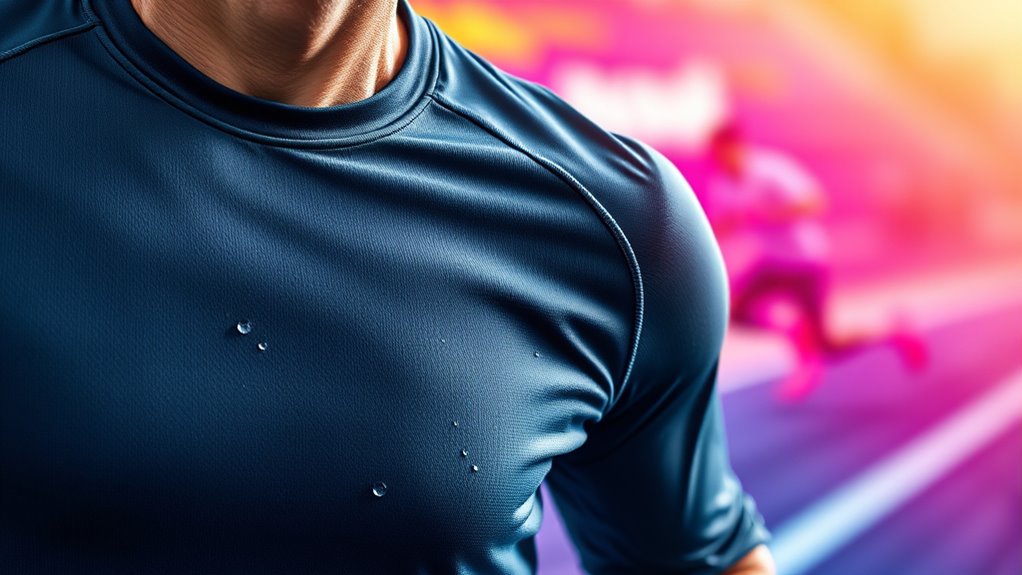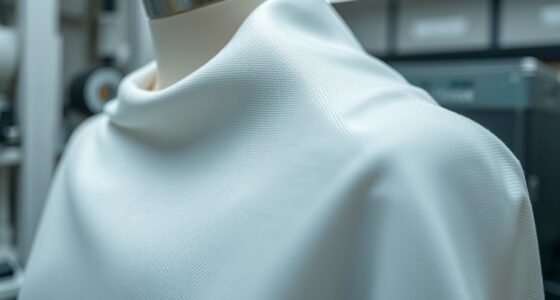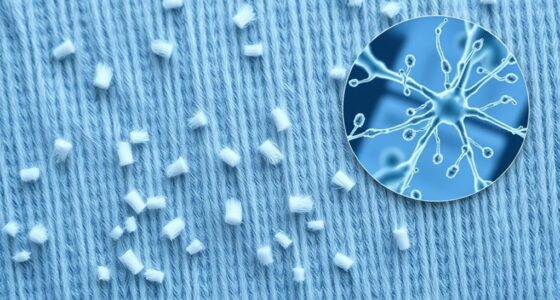Moisture-wicking athletic fabrics stay cool by quickly pulling sweat away from your skin and allowing airflow to pass through easily. They’re made with synthetic fibers like polyester or nylon, which spread sweat into thin, vaporizing layers. Special weaves and treatments boost breathability and quick-drying, helping you stay dry and comfortable during activity. If you’d like to uncover how these fabrics truly work together to create that magic, there’s more to explore.
Key Takeaways
- Fabric composition with synthetic fibers like polyester or nylon enhances breathability and quick moisture dispersal.
- Special weaves and knit patterns create channels that promote airflow and facilitate sweat evaporation.
- Hydrophobic treatments repel water, helping sweat move away from the skin for faster drying.
- High breathability allows air to pass through, preventing overheating and maintaining a cool body temperature.
- The combination of moisture-wicking fibers, fabric design, and airflow management creates the “magic” of cool, comfortable athletic wear.

Moisture-wicking fabrics have become essential in activewear because they pull sweat away from your skin, keeping you dry and comfortable during workouts. This effect relies heavily on fabric breathability, which allows air to pass through the material easily. When your clothing is breathable, it creates a channel for heat and moisture to escape, preventing your body from overheating. The process of sweat evaporation then kicks in, as moisture on your skin transforms into vapor and disperses into the air. This combination of breathability and sweat evaporation is what makes athletic fabrics feel so effective at managing moisture. You’ll notice that high-quality moisture-wicking fabrics are designed with special weaves or knit patterns that promote airflow. These fabrics often incorporate synthetic fibers like polyester or nylon, which are naturally more breathable than traditional cotton. The weave allows air to circulate freely, which helps sweat evaporate faster. As sweat moves to the surface of the fabric, it spreads out in thin layers, increasing the rate of evaporation. This quick-drying property not only keeps you comfortable but also helps prevent chafing and irritation caused by damp clothing. fabric breathability is a crucial factor in optimizing moisture management. When you’re active, your body produces heat and sweat, and the right fabric ensures these are managed efficiently. Breathability isn’t just about letting air in; it’s about creating a system where moisture can escape quickly. The faster sweat evaporates, the sooner your body can cool down, maintaining your performance and focus. If your activewear isn’t breathable enough, sweat tends to linger, making you feel clammy and heavy, which can hinder your workout. That’s why choosing garments with good fabric breathability is key to staying comfortable and dry, especially during intense sessions. In addition to breathability, moisture-wicking fabrics often feature treatments or finishes that enhance their ability to repel water and improve sweat evaporation. Some fabrics are engineered with hydrophobic properties, meaning they repel water and push moisture away from your skin. This synergy between fabric breathability and sweat evaporation creates a dynamic barrier against discomfort, helping you stay dry even during the most vigorous activities. When you understand how these elements work together, you realize that the magic behind athletic fabrics isn’t just in the material but in their design to optimize airflow and moisture management. In short, the secret to moisture-wicking magic lies in how well the fabric breathes and how quickly it allows sweat to evaporate. These qualities work together to keep you dry, comfortable, and performing at your best, no matter how intense your workout gets.
Frequently Asked Questions
How Do Moisture-Wicking Fabrics Impact Long-Term Durability?
You might notice that moisture-wicking fabrics can affect fabric longevity over time. Frequent washing, especially with harsh detergents, can degrade the fibers and reduce their effectiveness. While these fabrics are designed for durability, improper care can lead to quicker wear and tear, impacting their performance. To maintain their moisture-wicking qualities and extend their lifespan, follow proper washing effects and care instructions carefully.
Are There Eco-Friendly Moisture-Wicking Fabric Options Available?
Did you know that the eco-friendly textile market is expected to reach $10 billion by 2027? You can find moisture-wicking fabrics made from sustainable materials like recycled polyester and bamboo, which reduce environmental impact. These eco-friendly options often use eco-friendly dyes, ensuring your athletic wear stays functional and sustainable. By choosing these fabrics, you support a greener future while staying comfortable and dry during your workouts.
How Do Moisture-Wicking Fabrics Perform in Extreme Weather Conditions?
In extreme weather, moisture-wicking fabrics help keep you comfortable by quickly moving sweat away and promoting breathability enhancement. They also offer some thermal insulation, so you stay warm in cold conditions without overheating. However, their performance depends on fabric type and layering. You’ll find that in hot weather, these fabrics prevent overheating, while in cold, they provide insulation, making them versatile for various extreme conditions.
Can Moisture-Wicking Fabrics Cause Skin Irritation?
Imagine your skin feeling itchy or burning after wearing a new shirt—that’s skin sensitivity reacting to fabric. Moisture-wicking fabrics can sometimes cause skin irritation due to fabric reactions, especially if you have sensitive skin. Although designed to keep you dry, certain materials or chemicals used in manufacturing might trigger rashes or discomfort. If this happens, look for hypoallergenic options or fabrics free of harsh dyes and finishes to keep your skin happy.
What Innovations Are Emerging in Moisture-Wicking Technology?
You’ll find that emerging innovations in moisture-wicking technology focus on smart textiles and nanotechnology advancements. These advancements enable fabrics to respond dynamically to sweat levels, adjusting breathability and moisture transport in real-time. Smart textiles incorporate sensors that monitor moisture and temperature, enhancing comfort. Nanotechnology creates ultra-thin, highly efficient fibers that improve moisture management, making athletic wear even cooler, more comfortable, and highly functional for your active lifestyle.
Conclusion
Remember, the key to staying cool and comfortable is choosing the right fabric. Moisture-wicking materials pull sweat away from your skin, keeping you dry and refreshed during your workout. Think of these fabrics as your personal hydration heroes, working silently behind the scenes. As the saying goes, “A chain is only as strong as its weakest link.” When you wear the right gear, you’re set to perform at your best, no matter the heat.










